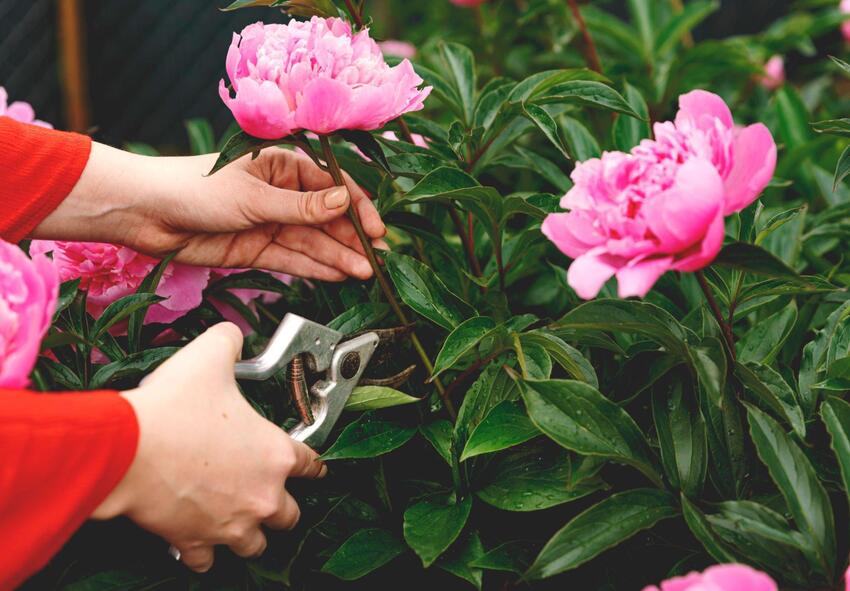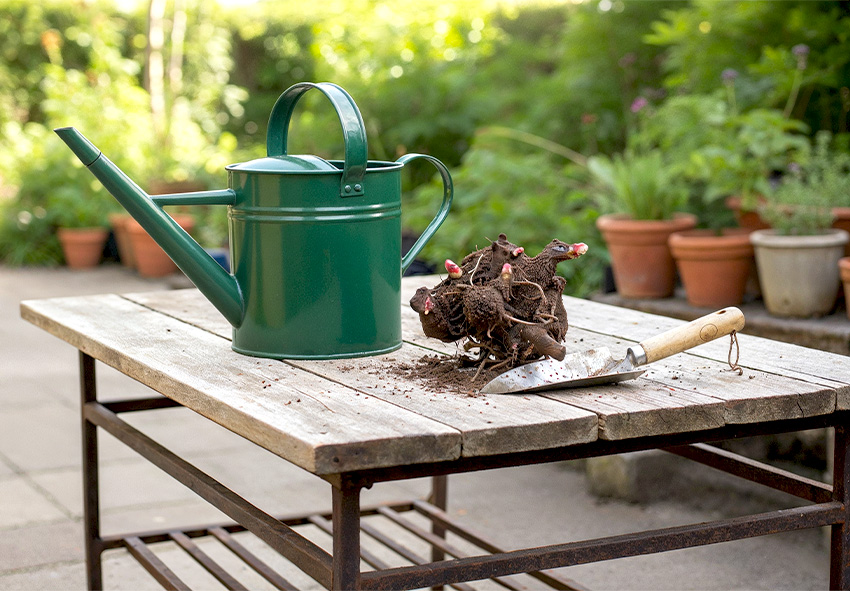Peonies are timeless garden favorites, known for their lush, fragrant blooms and remarkable longevity. With proper care, they can thrive for decades in the same spot. But what if you’d like to share their beauty across your garden — or with friends? That’s where peony propagation comes in.
Learning how to propagate peonies is easier than you might think. By using the right method and timing, you can successfully grow new peonies that mirror the beauty and health of your original plants. Our gardening blog is a perfect place to find any information you need!
Why Propagate Peonies?

Propagating peonies allows gardeners to multiply beloved varieties, rejuvenate aging plants, and maintain genetic consistency. It’s a cost-effective and rewarding way to expand your garden while ensuring each new plant retains the same stunning bloom and fragrance as the parent.
Unlike growing from seed, peony root division produces identical plants, ensuring you get the same flower color, form, and growth pattern. It also revitalizes old peony clumps that have become dense and less productive over time.
When Is the Best Time for Peony Propagation?
Timing plays a major role in successful peony propagation. The best time to divide and propagate peonies is late summer to early autumn — typically between late August and October.
During this period, the foliage begins to die back, and the roots store energy for next year’s growth. The soil remains warm enough for root establishment before winter sets in, which helps ensure vigorous new shoots in spring. Avoid dividing peonies in spring, as it can disturb active growth and reduce flowering the following year.
Methods of Peony Propagation
There are several ways to propagate peonies, but root division remains the most reliable and commonly used method for home gardeners. Other methods, like growing from seeds or cuttings, can work but require more patience and specific conditions.
1. Propagating Peonies by Root Division (Most Common Method)
The root division method is the easiest and most effective way to propagate peonies. It allows gardeners to separate a mature plant into multiple healthy divisions that will each grow into a new peony. With good technique, these new plants will bloom within two to three years.
Step-by-step guide to root division:
- Prepare the plant and area. Water the plant well the day before dividing and loosen the soil around it.
- Dig up the peony carefully. Use a garden fork to lift the entire clump without damaging roots.
- Clean and inspect the root system. Gently wash away soil to reveal the “eyes” — the small pink buds that produce new shoots.
- Cut healthy divisions. Use a clean, sharp knife to divide the root clump into sections, each containing 3–5 eyes and a good portion of root.
- Replant immediately. Set divisions in fertile, well-drained soil about 5 cm below the surface, and water thoroughly.
Aftercare is also important for your plants. Once planted, water deeply to help the soil settle around the roots. Apply a thin layer of mulch to retain moisture and protect against early frost. Avoid fertilizing until spring — peonies prefer time to settle before feeding. When new shoots appear, water regularly but don’t let the soil become soggy.
2. Propagating Peonies from Seeds (For Advanced Gardeners)
Growing peonies from seeds is possible but requires patience and a long timeline. Seed propagation is mainly used by breeders to develop new hybrid varieties.
Peony seeds must be collected when ripe, then undergo a period of stratification — exposure to alternating warm and cold conditions to stimulate germination. Even under ideal conditions, seedlings may take five to seven years before producing their first blooms. For most gardeners, propagation by root division is the faster and more reliable choice.
3. Propagating Peonies from Stem Cuttings (Less Common)

Some herbaceous peonies can be propagated from stem cuttings, though this method is less predictable. Cuttings should be taken in early summer from new growth, treated with rooting hormone, and planted in a warm, humid environment. While a few may root successfully, most gardeners find this method far less effective than dividing mature roots.
Choosing the Right Tools and Materials
Having the correct tools makes peony propagation smoother and more successful. You’ll need:
- A sharp, sterilized garden knife or pruning shears.
- A sturdy shovel or garden fork.
- Gardening gloves.
- Clean buckets and breathable storage bags for bulbs.
- Well-draining, fertile soil enriched with compost.
Always sterilize cutting tools before use to prevent transferring diseases between plants. Proper hygiene and gentle handling of roots are key to healthy divisions.
Caring for Newly Propagated Peonies
Newly divided peonies need some extra attention to establish strong roots and adapt to their new environment.
Watering and Mulching
Keep the soil consistently moist but not waterlogged. A layer of mulch helps maintain even moisture and protects young roots from temperature fluctuations. During dry spells, water deeply once a week to encourage downward root growth.
Fertilizing Young Plants
Avoid fertilizing immediately after planting peony roots. Once new growth appears in spring, apply a slow-release, balanced fertilizer (such as 10-10-10) sparingly. Too much nitrogen can cause lush foliage at the expense of blooms. Compost or organic matter added each fall will gradually improve soil fertility without overfeeding.
Signs of Successful Peony Propagation
After a few weeks, healthy root development will begin underground. By spring, you should see new shoots emerging — a clear sign your propagation was successful. Mature blooms typically appear in the second or third year, depending on growing conditions and care. With patience, your new peonies will flourish just like the parent plant.
Common Mistakes to Avoid During Peony Propagation

Even experienced gardeners can make small errors that affect success rates. Peony propagation requires patience, precision, and proper timing — small oversights can delay flowering or even damage your plants. To help your peonies thrive, avoid these common pitfalls:
- Dividing too early or too late in the season — roots need warmth to establish before winter sets in. Late divisions often struggle to grow before frost.
- Planting divisions too deep, which delays blooming and prevents buds from emerging properly in spring. Keep the eyes (buds) just 5 cm (2 inches) below the soil surface.
- Using dull or dirty tools that can damage roots or spread disease. Always use a sharp, sanitized knife or spade when dividing peonies.
- Overwatering, especially in heavy clay soils, which can cause rot and fungal problems. Allow soil to dry slightly between waterings.
- Fertilizing too soon, which can stress young divisions and lead to weak root growth. Wait until the following spring to feed lightly with a balanced fertilizer.
By avoiding these mistakes and following best propagation practices, you’ll ensure your new peonies establish quickly and reward you with healthy, vibrant blooms for many seasons to come.
Conclusion
Propagating peonies from root division is a simple, reliable, and rewarding way to expand your garden. Not only does it rejuvenate older plants, but it also allows you to share your favorite varieties with others. With the right timing, tools, and aftercare, you’ll enjoy healthy, blooming peonies for years to come — proof that a little patience in autumn brings spectacular rewards in spring!
Frequently Asked Questions (FAQs) about Peony Propagation
1. When is the best time to divide and propagate peonies?
The ideal time to divide and propagate peonies is from late August to early October. During this period, the foliage starts to die back, and the plant stores energy in its roots. The soil remains warm enough for new root growth before winter, ensuring healthy plants in the following spring.
2. How long does it take for divided peonies to bloom?
Newly divided peonies usually take two to three years to produce their first full blooms. While you may see foliage growth in the first spring, flowering takes longer as the roots establish themselves. Patience pays off — once mature, these peonies will bloom reliably for decades.
3. Can I order peony bare-root plants from your online store?
Yes, you can! Our online store Dutch-bulbs.com offers a wide selection of peonies plants, including different varieties and colors. We take pride in providing top-quality plants that are carefully cultivated and shipped with care to ensure they reach you in perfect condition.
4. How deep should I plant peony divisions?
When replanting peony divisions, position the eyes (buds) about 5 cm (2 inches) below the soil surface. Planting too deep can delay or prevent flowering. Ensure the site has well-drained soil and receives full sun for at least six hours daily to encourage strong root and flower development.
5. Why aren’t my newly propagated peonies flowering yet?
Newly propagated peonies may not flower in the first year because they’re focusing on root establishment. Other causes include planting too deep, poor sunlight, or overfertilization. Give them time — with proper care and sunlight, your peonies will start blooming beautifully by the second or third growing season.
Published: 04.11.2025
